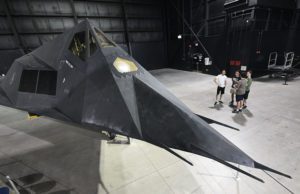
As we recognize the first anniversary of the F-117 Nighthawk’s arrival at Utah’s Hill Aerospace Museum, it’s the perfect time to answer some of the most commonly asked questions about the “Midnight Rider” and stealth aircraft technology.
What is Stealth Aircraft Technology?
The concept of stealth aircraft technology, also termed low observable technology (LO technology), is a military tactic designed to hide the presence of aircraft from enemy forces. Rather than render an aircraft invisible, it reduces the radar signature to decrease detectability. We’re all familiar with camouflage, for example, which helps a person or object blend into the background. Stealth aircraft are designed to avoid detection during flight by using a combination of multiple and different technologies such as radar, infrared, radio frequency (RF) and even thermal and acoustic reductions.
Origin of the F-117
The F-117 Nighthawk first rolled out in 1981 in a shroud of secret test flights for seven years, until it’s first public appearance at Nellis Air Force Base. The single-seat, twin-engine, strike-fighter stealth aircraft was designed by Lockheed Martin’s Skunk Works Division, and was the first operational aircraft completely undetectable by enemy radar. Although the aircraft was used in combat during Operation Just Cause in 1989, the first public, large-scale use of the F-117 was during the 1991 Gulf War.
How Shape Affects Stealth Aircraft Technology
 Aircraft shape has an impact on radar detectability. Ground radar, for example, can detect non-stealth aircraft from long ranges because of the size of its cross-section. A stealth aircraft such as the F-117, however, has a small radar cross-section, which makes it harder to detect from long distances. Stealth aircraft also avoid protrusions such as external engine air intakes or weapons.
Aircraft shape has an impact on radar detectability. Ground radar, for example, can detect non-stealth aircraft from long ranges because of the size of its cross-section. A stealth aircraft such as the F-117, however, has a small radar cross-section, which makes it harder to detect from long distances. Stealth aircraft also avoid protrusions such as external engine air intakes or weapons.
One of the most efficient ways to reflect radar waves is with orthogonal metal plates. In the case of the F-117, the tail surfaces are tilted to reduce corner reflections and the sharp angled surfaces provide a predictable direction of deflection. However, this flat, angled design presents a weakness in aerodynamics. Accordingly, the F-117 was inherently unstable and required a fly-by-wire control system. Newer stealth aircraft include some curves, such as the cockpit’s canopy, but today’s technology also allows engineers to predict the exact measure of radar beams with the aircraft’s surfaces, as well as design stealthy shapes that reduce heat signature to avoid infrared detection.
Stealth Coatings and Materials
 Another way to reduce the radar cross-section of an aircraft is by absorbing or reflecting radio waves in different directions so that a radar station is unable to receive or detect them. Some aircraft, such as the F-22 Raptor, use radio-wave absorbing materials (RAM) on the airframe. This paint contains tiny balls of iron oriented to create a magnetic field that dissipates the radio waves as heat. Carbon-based materials may also coat the plane to reduce radar detectability. A transparent conductor coating on the cockpit’s glass canopy also helps reduce radar profile, while maintaining pilot visibility.
Another way to reduce the radar cross-section of an aircraft is by absorbing or reflecting radio waves in different directions so that a radar station is unable to receive or detect them. Some aircraft, such as the F-22 Raptor, use radio-wave absorbing materials (RAM) on the airframe. This paint contains tiny balls of iron oriented to create a magnetic field that dissipates the radio waves as heat. Carbon-based materials may also coat the plane to reduce radar detectability. A transparent conductor coating on the cockpit’s glass canopy also helps reduce radar profile, while maintaining pilot visibility.
New Stealth Technology
Stealth aircraft technology is constantly evolving. The development of carbon-based nano-tubing, for example, can render an aircraft undetectable by radar and completely cloaked at night. Due to the cost of stealth coatings, there’s a renewed focus on continually redefining aircraft shape to help deflect radar beams while creating a more stable aircraft.
See an F-117 in Person
Hill Aerospace Museum’s F-117 is located in the Lindquist Stewart Gallery. Click here to watch the restoration in progress.
